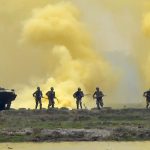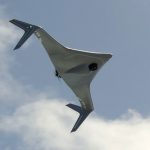
India’s Military Industrial Complex (TASL’s Barrel Manufacturing Facility as a Strategic Catalyst)
August 17, 2025

Blog

ISR – An Integrated Approach in the ‘Defence Year of Transformation’
Posted by admin
by – Brig Ashis Bhattacharyya
Intelligence is a decisive weapon in modern warfare, enabling faster decisions and precision strikes. As India advances its defence capabilities, integrating AI-driven ISR and strike systems into a unified command structure is essential for achieving battlefield dominance and operational superiority.
The ability to see, decide, and strike first determines victory. As India embarks on the ‘Defence Year of Transformation,’ the focus must shift beyond acquiring Arms/Service led ISR and strike abilities to integrating these capabilities into a seamless, AI-driven warfare ecosystem. The fundamental challenge is not a lack of resources but fragmentation—intelligence flows remain service-specific, decision-making is siloed and hence manual, and degradation resources (kinetic and non-kinetic) are not optimally networked. India must create an AI-Based Multi-Modal Fusion Command, where ISR dominance and degradation capabilities integrate at a national level.
India’s ISR Capabilities
India fields a formidable array of ISR platforms across domains. In space-based ISR, satellites like RISAT, CARTOSAT, and EMISAT provide ELINT, while GSAT-7 ensures secure communications. Airborne ISR assets include AWACS, AEW&C (Netra, Phalcon), MQ-9B, and Heron drones. The Indian Navy deploys P-8I Poseidon aircraft, MF-STAR on destroyers, UUVs and USVs. On land, Swathi WLR, BFSRs, HUMINT, MASINT, and SIGINT nodes enhance battlefield awareness. Cyber and EW ISR capabilities are available through NTRO’s cyber operations, as well as Samyukta and Himshakti jamming systems.
India’s Degradation Capabilities
India possesses a robust mix of kinetic and non-kinetic strike capabilities, including:
- Missile and Precision-Strike Systems. Prithvi, Agni, BrahMos, Pralay, Shaurya, Pinaka MBRLs, Artillery Gun Systems (TGS and MGS) and precision-guided bombs (Spice-2000, Hammer).
- Electronic Warfare & Cyber Disruption. Directed Energy Weapons (DEW), Microwave Systems (KALI-5000), and cyber-offensive capabilities.
- AI-Enabled Loitering Munitions & UCAVs. ALFA-S, Nagastra, Ghatak UCAVs.
However, these capabilities remain fragmented, operating under service-specific protocols instead of a joint, AI-integrated command structure. Existing frameworks such as IACCS (Air Force), AFNET (Air Force), and NC3I (Navy) need to evolve into a singular, theatre-level intelligence and targeting network. While the NGF and IDSC initiatives are promising, they focus on specific ISR areas without integrating degradation networks for automated targeting and neutralisation.
Unified AI-Based ISR-Degradation Framework. A truly network-centric warfare model requires real-time, AI-driven ISR fusion that seamlessly integrates:
- Multi-Source Intelligence. HUMINT, SIGINT, IMINT, MASINT, OSINT, and Cyber Intelligence.
- AI-Driven Predictive Targeting. Automated threat prioritization and pre-emptive engagement.
- Quantum-Enabled Secure Communications. Hosted on a ‘Defence Cloud’ with GPU-based computing power.
While India’s recently announced AI Mission has empanelled 18,639 GPUs, the defence forces must incorporate this capability into ISR and degradation networks as well.
The proposed AI-Based Multi-Modal Fusion Command would aggregate data from ISR sources, creating a Common Intelligence Picture (CIP). AI-driven automation would allocate degradation resources—whether kinetic (missiles, loitering munitions, SEAD operations) or non-kinetic (jamming, cyber disruption, directed energy weapons)—in real time. This framework must integrate all domains: Army, Navy, Air Force, Space Command, and Cyber Warfare Units.
Global ISR-Degradation Integration Models. Nations with advanced ISR-driven degradation capabilities operate centralized, AI-based intelligence processing models:
- United States. Transitioned from JSTARS & JTIDS to JADC2 (AI-driven Joint All-Domain Command & Control), integrating ISR with strike capabilities across the Army, Navy, Air Force, Space Force, and Cyber Command.
- Russia. Sistema Razvedki i Upravleniya (REZ-IS) fuses ISR data to direct precision EW attacks using Krasukha systems, S-500 Air Defence, and Orlan-10 UAVs.
- Chin.: Integrated Network-Electronic Warfare (INEW) combines AI-driven cyber warfare, ISR satellites (Gaofen, Yaogan), and stealth drones (Sky Hawk, J-20) into a unified command structure.
- NATO/EU. The MUSIS (Multinational Space-Based Imaging System) and SCORPION ISR Program centralize ISR networks across allied forces.
India must develop its own version of JADC2 or REZ-IS, creating an AI-driven National ISR & Strike Coordination Command.
The Way Forward
A National Mission for a Joint ISR-Strike Command should be established, incorporating:
- National or Theatre-Level Joint ISR Fusion Centres. Real-time intelligence processing with AI & Big Data integration.
- AI-Driven Decision Support Systems. Automated threat prioritization and rapid target allocation.
- Quantum-Hardened Cloud Networks. Secure ISR-sharing among all forces.
- Autonomous AI-Driven Processing. Optimized munition and EW resource deployment.
- Defence Large Language Model (LLM). This step will provide the sovereign autonomy for Indian Defence Forces.
With India’s growing defence startup ecosystem, companies like Pixxel, IdeaForge, BBBS, Optimised Robot Solutions and NewSpace etc to name a few, have the potential to develop AI-driven ISR solutions. Integrating commercial ISR solutions into military networks will further enhance capabilities. With artillery, missiles, satellites, AFVs, and EW equipment now produced domestically (common protocols and interfaces can be ensured), gridding these a feasibility now. With its vast talent pool in over 1,800 GCCs, necessary indigenous expertise is available , provided with the right incentives.
Importantly, formation of an ISR & Strike Command must be treated as a National Level Mission, bypassing restrictive DAP and DPM processes. The inefficiencies of L1-based procurement must be strictly avoided. One should study successful national programs like IGMDP (Integrated Guided Missile Development Program), ATV (Advanced Technology Vessel), DMRC (Delhi Metro Rail Corporation), and ADA (Aeronautical Development Agency) and adopt some of their best practices.
Conclusion. India possesses the ISR assets, kinetic and non-kinetic strike capabilities, and integration technologies. What hinders progress is just ‘siloed thinking’. The Defence Year of Transformation must mark the shift from service-specific ISR & D models to a national, AI-driven Multi-Modal Fusion Command. This is not just a technological necessity—it is a strategic imperative. The transformation must begin now. The future battlespace will not wait.
Search Blog
Categories
Popular Posts






